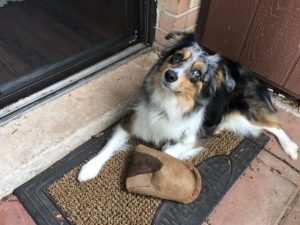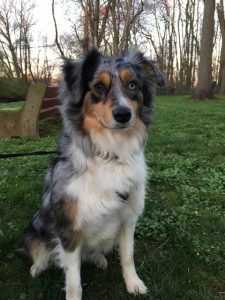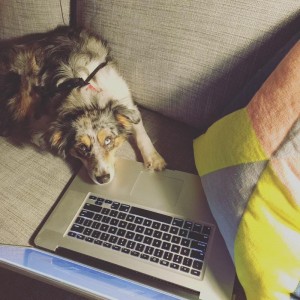By David DelCollo, Attorney
It is a daily routine: my dog, Marley and I wake up early and go for a long walk, followed by a short game of frisbee, and finally breakfast. It is all smiles for Marley until I turn on the shower to begin getting ready for work,-that is her cue that I will soon be leaving for the day and it is at this point that her whole demeanor transforms. She goes from the energetic, happy dog to very lethargic with a look on her face that always breaks my heart.
While we all love the company and companionship of our favorite canine, most of us do not have the luxury of being able to spend our working hours with our dogs. For us that tend to work lots of hours, this ultimately means that our dogs will spend a lot of time apart from us during the work week and a simple internet search of people who set up camera’s in their homes to spy on their dogs when their away reveals one absolute truth: dogs get lonely. And as tempting as it may be to quit your job and abandon all of your responsibilities so you can never leave your best friend’s side,-that is probably not the best long-term solution. Rather, here are 8 ways to alleviate your dog’s loneliness when you are away, and make for a much happier dog and guilt-free owner:
- The Television Baby-sitter. Since our dogs are very accustomed to our televisions being on when we are home, a quiet-home when we are away can be deafeningly silent. Keeping the television on will create the same ambiance and atmosphere that exists when we are home with the dog and lounging on the sofa. My personal favorite is Animal Planet (Pitbulls & Parolees), as there are a lot of dog shows on during the day filled with barking and animal sounds that will give your furry friend the feeling of being surrounding by others.
- Bird (and squirrel) Watching. If your dog is anything like mine, they can spend countless hours watching and dreaming of the day that they will finally catch one of those squirrels. If you have a window facing a tree or some area where there are a lot of birds, make this area comfortable for your dog to sit for a while and observe. Maybe use a cushion, dog bed, or blanket to make this area more inviting and once they are start getting absorbed into watching the great outdoors, hours will pass by and maybe even a good nap will ensue.
- A Tired Dog is a Sleepy Dog. On average, dogs can sleep about 16 hours a day and unless you work in a sweatshop, this should mean that they can spend a majority of your working hours catching up on sleep. This is especially true if you can tire your dog out a bit before you head out the door in the morning.
- The Peanut-Butter Solution. If your dog is anything like Marley, my Aussie, then they absolutely love peanut butter. Use this to your advantage by taking a healthy wad of peanut-butter and sloshing it in one of their favorite toys. The peanut butter will pack into the crevices, keeping your dog busy for hours while they attempt to get every last drop of peanut creamy goodness into their bellies. If you don’t have any toys that will work well for this, the pet store also sells a variety of fillable toys for this very purpose.
- Keep Some Light on the Subject. Similar to the television, when we are home with our dogs we usually have some or most of the lights lit. While I am not recommending that you waste energy when you are away, keep some lights on in those areas where you usually spend the most time with your pet. A home that contains a lot of the same activity as when you are there with the dog creates an atmosphere that is comforting and soothing to the dog. We want to try to stay away from creating a drastically different environment in the home when we leave for the day, as this makes it much more easy for your animal to cope with your absence.
- Hang on to that Old T-shirt. A piece of your clothing that retains your scent or even a blanket that you have used often can be a great security object for your dog when you are away. As we all know, dog’s are very intuitive creatures that utilize familiar scents in order to provide them with information on their surroundings and circumstances. Having a scented object that your dog can lie with makes the dog feel your presence even when you are not there. Also, leaving a scented object with your dog can help your dog to understand and learn that you have not left for good, which is the dog’s greatest fear every time you step away. I recommend keeping some old t-shirts in a special place and when you leave for the day, get one out and place it where your dog likes to lay.
- The Day-Care Option. We now have the option of doggy day-cares, something unheard only a few decades ago. Most doggy day-cares today resemble those of child day-cares, in that they are open environments in which the dogs can play and interact under the supervision of a trained staff member, with some even offering nap-time, snacks, and games. Most doggy day-cares range from about $15-$35 dollars per day, depending on the facility and the services offered. Even if you do not have the finances or desire to bring your dog to a day care every day you are away, bringing your dog a few times a week can break up the monotony and long-stretch your dog is alone between your days off. These facilities are also great because they provide your dog with the opportunity to socialize with other animals and become an overall more well-rounded and happy animal.
- The Doggysitters Club. Similar to babysitters, there are many people that will come to your home and spend time with your dog during the day when you are away. My favorite resource for this is Rover.com, which is a website that matches people with dog sitters. On this site you can search by area, see their rates, read reviews, and even shoot your potential dog sitter with an email to discuss their services further. In addition, you can hire someone for as little as 15 minutes to just stop by, check on your dog, and take them for a brief walk, or you can hire someone to watch your dog for days,-as well as everything in between. I think this is an amazing resource in curing your dog’s blues.





